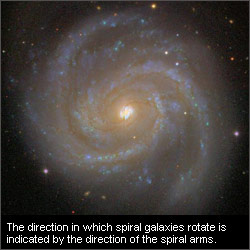|
The Science
What can galaxies tell us about the wider Universe?
 It is not only those of us studying galaxy formation who are curious about the shapes of galaxies. Cosmologists who study the origin and properties of the Universe itself can also learn from observations of galaxies and, in particular, their rotation. Generally galaxies rotate, and the details of their rotation (angle, speed, direction) depends on the way that they formed and on the properties of the space around them - such as the presence of magnetic fields, or the tidal pull from other structures.
It is not only those of us studying galaxy formation who are curious about the shapes of galaxies. Cosmologists who study the origin and properties of the Universe itself can also learn from observations of galaxies and, in particular, their rotation. Generally galaxies rotate, and the details of their rotation (angle, speed, direction) depends on the way that they formed and on the properties of the space around them - such as the presence of magnetic fields, or the tidal pull from other structures.
Galaxies form from the gravitational collapse of much larger clouds of gas and, if the cloud has any rotation to start with, it will rotate faster as it gets smaller. This is similar to the way an ice-skater spins faster as they pull their arms in, and it is due to the conservation of angular momentum. In fact, it is this rotation that stops the galaxies collapsing any further as the gravity provides just enough force to keep the gas in its rotational orbit. Thanks to the spiral arms, it is straightforward to observe the rotation direction of spiral galaxies (clockwise or anti-clockwise) just by looking at them. We think that neighbouring galaxies will have formed from the same original large gas cloud. Therefore we expect close galaxies to share some properties, including the angle at which they rotate. By looking at these shared properties over different distances we can tell a lot about the process through which they formed.
But what about the wider Universe? Observing the rotation of galaxies also provides a probe of the large-scale properties of the Universe, and intriguingly there is already some indication from SDSS galaxies that all may not be as it seems! Our current theories about the Universe have it that galaxies should not prefer to rotate one way or the other, and we should therefore observe as many clockwise rotating spiral galaxies as anti-clockwise. This is related to a fundamental assumption we make in cosmology; that there are no special places or special directions in the Universe. Prof. Micheal Longo from the University of Michigan has claimed, in his recent astro-ph preprint, that there is a preferred handedness (rotation direction) of galaxies in the local Universe. This is a revolutionary claim, that could force us to rethink our understanding about the underlying nature of space and employ a much more complicated background model for the Universe. The current claim is based on a sample of just 1660 galaxies from the SDSS survey, but a much larger sample is required to assess the significance of the effect which is where Galaxy Zoo comes in.
Back
>
|